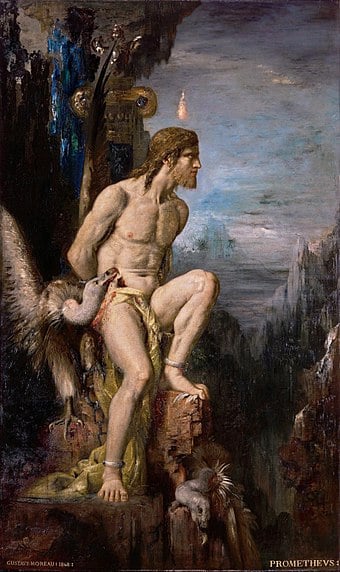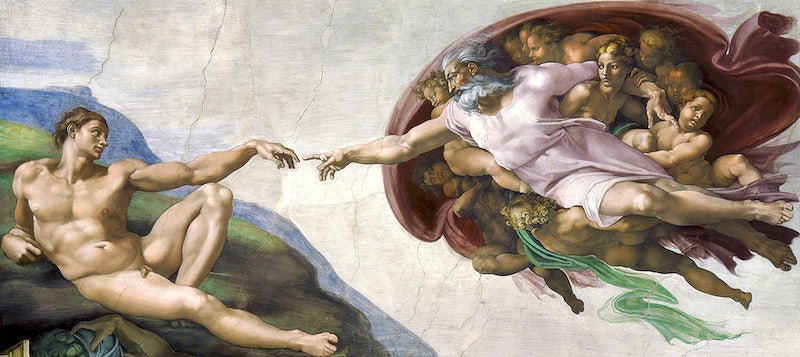
Christianity’s rapid spread in the classical Greco-Roman world begs a question. What made Christianity appealing or fulfilling for the classical world?
Trying to find answers is a task as old as time. All classical professions attempt to define the minute patterns of their trade. Historians read and analyze the past to understand the future (Thucydides). Philosophers attempt to use rationale while scientists aim to find truth and meaning in the earthly realm (Aristotle).
These professions study the human experience, yet not human existence. That responsibility belongs to poets who combine their rationale with their imagination to create myths and tales that address purpose, identity, and ideals such as love, liberty, and truth.
In this way, an intriguing idea emerges that Classical thought and mythology stand as a dim image, or mere reflection, of the profound truth later encapsulated in Christianity.
In the creation stories of humanity, a specific striking resemblance is found between Prometheus and Adam with Eve. Along with them, parallels of Jesus Christ with Heracles, and God with Zeus are found.

Prometheus and Adam With Eve
A striking parallel unfolds when contrasting the narratives of Prometheus from Greek mythology and Adam with Eve from the Judeo-Christian tradition. Prometheus, the Titan who defied Zeus to gift fire and knowledge to humanity, can be likened to Adam and Eve’s consumption of the forbidden fruit from the Tree of Knowledge.
In this parallel, the element of fire is of utmost importance. Fire provided mankind with power and dominion over creation and the animals.
In the case of Adam and Eve, they eat from the forbidden Tree of Knowledge. Their action is guided by the temptation of the serpent. The foul beast corrupted their purity through implementing a desire for power disguised as knowledge. Unable to control their desires, Adam and Eve succumb to it and defy the orders of God.
The Punishment
There are striking similarities in the punishments of Prometheus and Adam and Eve. Prometheus is chained in the boundaries of the then-known world, Caucasus. He is restricted through the divine chains of Hephaistos, and every day, an eagle arrives to eat his liver which regrows daily only to be eaten again. Adam and Eve are also faced with pain, even in the case of continuing the human race (physical pain of birth).
The punishment for their disobedience has three parts. First, they are exiled from the Garden of Eden. Second, they have to work for their food and struggle, implying a life of pain. Thirdly and perhaps most important, they will die.
In these punishments, there are three more parallels. Among these is Adam and Eve’s promise of death at the edge of the known world, the Caucasus. The chains of Hephaistos present the inability to re-enter the Garden and unite with God. The liver that regrows is humanity’s continuation through painful birth.
The timing of their punishment itself is another parallel. The ability to reason was already granted to mankind by Prometheus at the time of humanity’s creation. Fire was also later gifted to humanity. Similarly enough, Adam and Eve were created in the image of God and came to eat from the food of the tree.
In both predicaments, humanity (Adam and Eve) and Prometheus are banished without any possibility of reconciliation from their own accord. Their salvation can only be derived from divine authority.

Jesus Christ With Heracles: Redemption and Sacrifice
In the case of saviors, Christ and Heracles share significant similarities. It could be argued that Heracles resembles an abstract, polluted version of Christ. The son of the ultimate god Zeus, after his labors, Heracles receives an apotheosis, thus resembling the hypostatic union of Christ. An hypostatic union is the intertwining of the human nature and that of the Divine. In the context of the stories, with His death and resurrection, Christ saves Adam and Eve along with humanity.
As the epitome of the Easter chants, Christ breaks the gates of Hades, the trap of Satan, and saves humanity by raising Adam and Eve. Similarly, Heracles is the only being able to reach the Caucasus and free Prometheus. In both tales, a human and divine force was needed to save humanity from death, even though it was a divine-made punishment.
Zeus and Deus

In this quest for understanding classical thought and its metaphorical meaning, an uncanny relationship between Zeus and God emerges. In the case of Prometheus, Zeus is the punisher and instigator for his salvation (in Hesiod, not Aeschylus). Zeus instructs Heracles to free Prometheus, despite being the one who imprisoned him.
In a similar manner, God takes on the form of Christ. He descends into Hades and shatters its grip, rescuing humanity, even though it was He who initially cast them out. This reveals a paradox whereby both figures punish humanity but also exhibit a profound love that ultimately leads to their salvation.
The basic principle of classical thought focused on the quest for truth. In this quest for truth and meaning, tales emerged from poets who attempted to answer questions in relation to the human condition rather than only the experience. These tales led by this noble cause, identified a number of overall themes of humanity, which could only be completed through Christianity. Thus, Christianity spread rather rapidly in early classical Europe.
Figures like Prometheus and Adam, Jesus Christ and Heracles, and Zeus and God are therefore ideal examples for this continuous narrative whereby Classical thought serves as a precursor to the ultimate truths revealed in later Christian doctrine.
See all the latest news from Greece and the world at Greekreporter.com. Contact our newsroom to report an update or send your story, photos and videos. Follow GR on Google News and subscribe here to our daily email!



